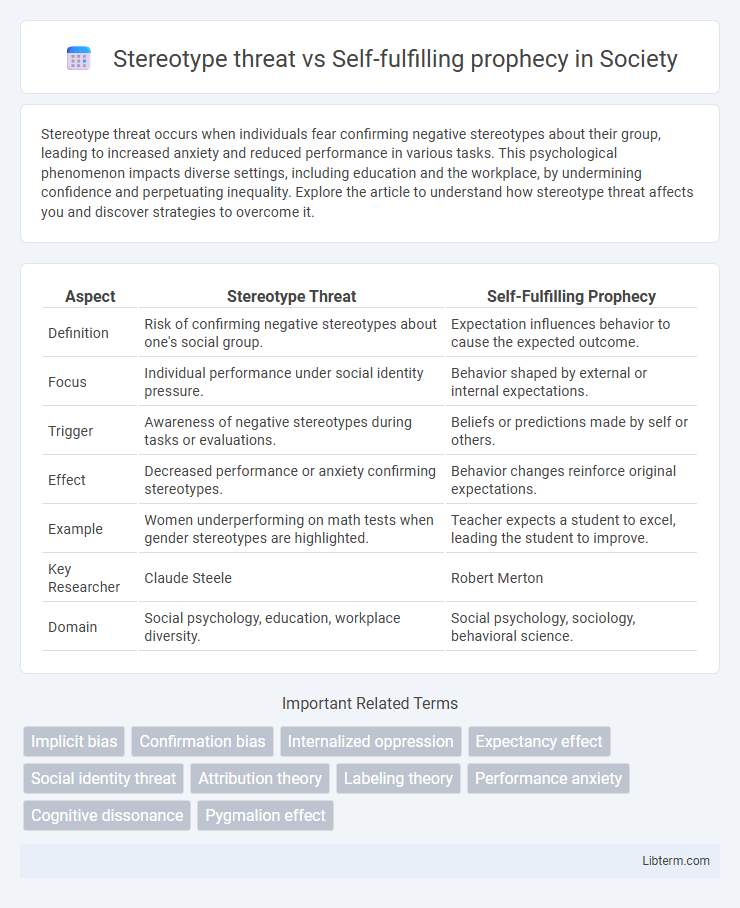Stereotype threat occurs when individuals fear confirming negative stereotypes about their group, leading to increased anxiety and reduced performance in various tasks. This psychological phenomenon impacts diverse settings, including education and the workplace, by undermining confidence and perpetuating inequality. Explore the article to understand how stereotype threat affects you and discover strategies to overcome it.
Table of Comparison
| Aspect | Stereotype Threat | Self-Fulfilling Prophecy |
|---|---|---|
| Definition | Risk of confirming negative stereotypes about one's social group. | Expectation influences behavior to cause the expected outcome. |
| Focus | Individual performance under social identity pressure. | Behavior shaped by external or internal expectations. |
| Trigger | Awareness of negative stereotypes during tasks or evaluations. | Beliefs or predictions made by self or others. |
| Effect | Decreased performance or anxiety confirming stereotypes. | Behavior changes reinforce original expectations. |
| Example | Women underperforming on math tests when gender stereotypes are highlighted. | Teacher expects a student to excel, leading the student to improve. |
| Key Researcher | Claude Steele | Robert Merton |
| Domain | Social psychology, education, workplace diversity. | Social psychology, sociology, behavioral science. |
Understanding Stereotype Threat
Stereotype threat occurs when individuals fear confirming negative stereotypes about their social group, leading to increased stress and diminished performance in relevant tasks. This psychological phenomenon is distinct from self-fulfilling prophecy, which involves others' expectations influencing an individual's behavior to confirm those expectations. Research in social psychology highlights that awareness of stereotype threat can impair cognitive functioning and academic achievement, particularly among marginalized groups.
Defining Self-Fulfilling Prophecy
Self-fulfilling prophecy is a psychological phenomenon where an individual's expectations about another person or situation influence their behavior, causing those expectations to come true. This concept highlights the power of beliefs in shaping outcomes through behaviors and interactions, often reinforcing the initial assumption. Unlike stereotype threat, which involves anxiety about confirming negative group stereotypes, self-fulfilling prophecy centers on how predictions or beliefs directly lead to their own fulfillment.
Key Differences Between Stereotype Threat and Self-Fulfilling Prophecy
Stereotype threat occurs when individuals fear confirming negative stereotypes about their social group, which impairs their performance, whereas self-fulfilling prophecy involves expectations that lead individuals to unconsciously behave in ways that confirm those expectations. Stereotype threat is triggered internally by anxiety about stereotypes, while self-fulfilling prophecy is externally imposed through others' expectations influencing behavior. Understanding these differences is crucial for addressing bias in educational and professional environments.
Origins and Psychological Mechanisms
Stereotype threat originates from Claude Steele and Joshua Aronson's research, highlighting the anxiety individuals experience when aware of negative stereotypes about their group, which impairs performance. Self-fulfilling prophecy, rooted in Robert K. Merton's sociological theory, describes how initial expectations influence behaviors to produce the predicted outcome. The psychological mechanism of stereotype threat involves cognitive load and stress reactions that reduce working memory capacity, while self-fulfilling prophecy operates through altered social interactions and confirmation biases reinforcing the initial belief.
Impact on Academic and Workplace Performance
Stereotype threat triggers anxiety in individuals who risk confirming negative group stereotypes, leading to decreased academic and workplace performance due to heightened cognitive load and reduced working memory capacity. Self-fulfilling prophecy occurs when expectations from teachers or supervisors influence individuals to conform to those beliefs, thereby impacting performance outcomes through behavioral changes and motivation shifts. Both phenomena contribute significantly to disparities in achievement, as stereotype threat undermines confidence while self-fulfilling prophecies reinforce biased assumptions, ultimately affecting productivity and learning efficacy.
Real-Life Examples and Case Studies
Stereotype threat occurs when individuals perform worse on tasks due to anxiety about confirming negative stereotypes about their group, as demonstrated in Claude Steele's studies where African American students underperformed on tests when race was emphasized. Self-fulfilling prophecy involves expectations leading to behaviors that cause the expected outcome, illustrated by Rosenthal and Jacobson's "Pygmalion effect" experiment where teachers' positive expectations improved student performance. Both phenomena have profound implications in education, workplace dynamics, and social interactions, influencing outcomes through psychological and behavioral mechanisms.
How Stereotype Threat Shapes Behavior
Stereotype threat shapes behavior by causing anxiety and reduced performance when individuals are aware of negative stereotypes about their social group. This psychological pressure leads to decreased working memory capacity and increased cognitive load, impairing task execution and motivation. As a result, stereotype threat perpetuates underachievement and reinforces existing social biases through diminished self-confidence and altered behavior.
Self-Fulfilling Prophecy in Everyday Life
Self-fulfilling prophecy occurs when an individual's expectations influence their behavior, causing those expectations to come true in everyday interactions. In educational settings, teachers' low expectations of students can lead to diminished academic performance, reinforcing initial beliefs. This phenomenon highlights how beliefs and attitudes shape social realities and personal outcomes across various contexts.
Strategies to Combat Stereotype Threat and Self-Fulfilling Prophecy
Effective strategies to combat stereotype threat include fostering a growth mindset, promoting diverse role models, and creating environments that emphasize individual abilities over group stereotypes. Interventions such as affirming personal values and providing positive feedback reduce the psychological pressure that leads to underperformance. Addressing self-fulfilling prophecy involves setting high expectations, offering consistent support, and encouraging self-efficacy to break cycles of negative assumptions and improve outcomes.
Implications for Education, Leadership, and Social Change
Stereotype threat undermines academic performance by causing anxiety in individuals who fear confirming negative group stereotypes, leading to reduced test scores and participation, while self-fulfilling prophecy in leadership can perpetuate low expectations and limit growth opportunities for marginalized groups. Addressing stereotype threat requires creating inclusive environments and teaching strategies that affirm positive identities, whereas combating self-fulfilling prophecy involves leaders actively challenging biases and fostering high expectations for all. Both phenomena highlight the importance of awareness and intervention in educational settings, leadership practices, and social change initiatives to promote equity and empowerment.
Stereotype threat Infographic

 libterm.com
libterm.com